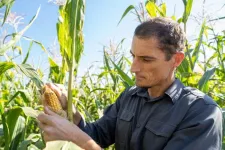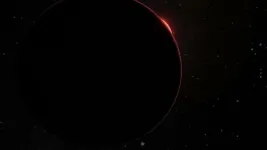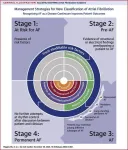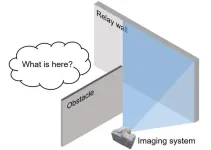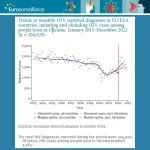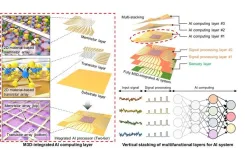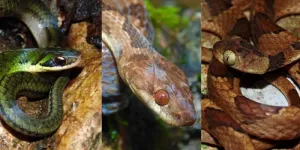(Press-News.org) The discovery of a Neptune-mass exoplanet orbiting the very low-mass M dwarf star LHS 3154 challenges theoretical models of planet formation, according to a new study. The planet, which has a mass at least 13 times that of Earth, tightly orbits a star 9 times less massive than the Sun, demonstrating that small stars can sometimes host larger planets than was previously thought. Planets form in the dense circumstellar discs of gas and dust that surround newborn stars. The amount of material in these structures determines how massive the planets that form within them can grow. Because the mass of dust contained in protoplanetary discs closely scales with the mass of the host star, theories of planet formation predict that red dwarf stars (M dwarfs – the least massive type of star) shouldn’t host close-orbiting exoplanets with masses greater than that of Neptune (17 Earth masses). Although massive planet candidates have been detected around a few very low-mass dwarfs, they have all exhibited very wide orbital periods. Using precise radial velocity observations in the near-infrared from the Habitable-zone Planet Finder (HPF) spectrograph, Guõmundur Stefánsson and colleagues report the detection of a massive exoplanet on a close orbit around LHS 3154, a very low-mass M dwarf star. Observations of LHS 3154 revealed Doppler shifts indicating the presence of an almost Neptune-mass exoplanet with an orbital period of 3.7 days. According to the authors, current theories of planet formation, including core-accretion and gravitational instability mechanisms, struggle to explain how such a massive planet formed around LHS 3154. Stefánsson et al. also performed planet formation simulations to show that the amount of dust in the protoplanetary disc that formed the planet would need to be at least 10 times greater than is typically observed in the protoplanetary discs surrounding low-mass stars. In a related Perspective, Frédéric Masset discusses how the LHS 3154 system challenges planet formation theory.
For reporters interested in trends, a September 2019 study by Morales et al. presented the detection of GJ3512b, another high-mass planet orbiting a very low-mass M dwarf star, but with a much longer orbital period.
END
A Neptune-mass exoplanet found closely orbiting a very low-mass M dwarf star
2023-11-30
ELSE PRESS RELEASES FROM THIS DATE:
Two teosintes made modern maize
2023-11-30
Broad genetic sampling of maize and its teosinte grass ancestors reveals evidence of wild admixture during the crop’s initial domestication and dispersal, according to a new study. The findings clarify the contentious origin of modern maize and raise new questions about the anthropogenic mechanisms underlying its spread throughout the Americas. The domestication of crops transformed human culture. For many crops, the wild plants that modern domesticates are most closely related to can be readily identified by morphological and genetic similarities. Yet, despite its global agricultural importance, the ancestry of modern maize has long ...
A mixed origin made maize successful
2023-11-30
Maize is one of the world’s most widely grown crops. It is used for both human and animal foods and holds great cultural significance, especially for indigenous peoples in the Americas. Yet despite its importance, the origins of the grain have been hotly debated for more than a century. Now new research, published Dec. 1 in Science, shows that all modern maize descends from a hybrid created just over 5000 years ago in central Mexico, thousands of years after the plant was first domesticated.
The ...
Discovery of planet too big for its sun throws off solar system formation models
2023-11-30
UNIVERSITY PARK, Pa. – The discovery of a planet that is far too massive for its sun is calling into question what was previously understood about the formation of planets and their solar systems, according to Penn State researchers.
In a paper published online today (Nov. 30) in the journal Science, researchers report the discovery of a planet more than 13 times as massive as Earth orbiting the “ultracool” star LHS 3154, which itself is nine times less massive than the sun. The mass ratio of the newly found planet with its host star is more than 100 times higher than that of Earth and the sun.
The finding reveals the most massive known ...
Early rhythm control, lifestyle modification and more tailored stroke risk assessment are top goals in managing atrial fibrillation
2023-11-30
The American College of Cardiology (ACC) and the American Heart Association (AHA), along with several other leading medical associations, have issued a new guideline for preventing and optimally managing atrial fibrillation (AFib). The guideline was jointly published today in the Journal of the American College of Cardiology and Circulation.
Atrial fibrillation, or AFib, is the most common type of heart rhythm disorder (arrhythmia), affecting over 6 million Americans, and the number is expected to double by 2030. AFib causes a variety of symptoms, including fast ...
Carbon dioxide becomes more potent as climate changes, study finds
2023-11-30
Embargoed: Not for Release Until 2:00 pm U.S. Eastern Time Thursday, 30 November 2023.
A team of scientists found that carbon dioxide becomes a more potent greenhouse gas as more is released into the atmosphere.
The new study, led by scientists at the University of Miami Rosenstiel School of Marine, Atmospheric, Science, was published in Science and comes as world leaders meet in Dubai, United Arab Emirates, this week for the United Nations Climate Change Conference COP28.
“Our finding means that ...
Researchers extend non-line-of-sight imaging towards longer wavelengths
2023-11-30
WASHINGTON — Emerging technologies for non-line-of-sight imaging can detect objects even if they are around a corner or behind a wall. In new work, researchers use a new type of detector to extend this method from visible light into near and mid-infrared wavelengths, an advance that could be especially useful for unmanned vehicles, robotic vision, endoscopy and other applications.
“Infrared non-line-of-sight imaging can improve the safety and efficiency of unmanned vehicles by helping them detect and navigate around obstacles that are not directly visible,” said Xiaolong Hu from Tianjin University in China. His team collaborated with a group ...
EU/EEA: HIV diagnoses rise for the first time in a decade
2023-11-30
Across the 30 countries of the European Union and European Economic Area (EU/EEA), 22,995 new HIV diagnoses were reported in 2022. Almost every second new HIV diagnosis (49%, n=11,103) was among migrants, i.e. among people who were not born in in the country they were diagnosed in. born abroad from the country of their diagnosis.
In the aftermath of Russia’s invasion of Ukraine in 2022, more than 4 million Ukrainians took refuge in countries of the European Union and European Economic Area (EU/EEA). In a rapid communication published in Eurosurveillance prior to World AIDS Day 2023 on 1 December, Reyes-Urueña et al. look at most recent surveillance data ...
2D material reshapes 3D electronics for AI hardware
2023-11-30
Multifunctional computer chips have evolved to do more with integrated sensors, processors, memory and other specialized components. However, as chips have expanded, the time required to move information between functional components has also grown.
“Think of it like building a house,” said Sang-Hoon Bae, an assistant professor of mechanical engineering and materials science at the McKelvey School of Engineering at Washington University in St. Louis. “You build out laterally and up vertically to get more ...
George Demetri, MD, of Dana-Farber earns Lifetime Achievement Award in Medicine from Stanford University School of Medicine
2023-11-30
Boston – George Demetri, MD, director of the Sarcoma Center at Dana-Farber Cancer Institute, is being awarded the prestigious J.E. Wallace Sterling Lifetime Achievement Award in Medicine from the Stanford Medicine Alumni Association (SMAA). Demetri, an alumnus of the Stanford University School of Medicine, Class of 1983, will be honored at a dinner held on the Stanford University School of Medicine campus on December 4, 2023.
“Dr. Demetri is a leader in developing targeted therapeutics for cancer and has been pivotal in advancing oncology treatments ...
Snake skulls show how species adapt to prey
2023-11-30
By studying the skull shapes of dipsadine snakes, researchers at The University of Texas at Arlington have found how these species of snakes in Central and South America have evolved and adapted to meet the demands of their habitats and food sources.
The research, conducted in collaboration with colleagues at the University of Michigan, was published in the peer-reviewed journal BMC Ecology and Evolution.
“We now have evidence that this group of snakes is one of the most spectacular and largest vertebrate adaptive radiations currently known to science,” said Gregory Pandelis, collections manager at UTA’s Amphibian and Reptile Diversity ...
